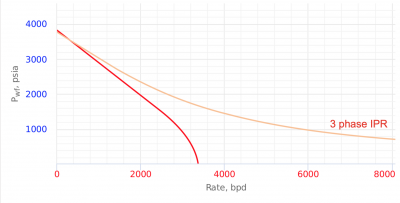Difference between revisions of "3 Phase IPR"
From wiki.pengtools.com
(→Solution:) |
(→3 Phase IPR calculation example) |
||
| (44 intermediate revisions by the same user not shown) | |||
| Line 1: | Line 1: | ||
__TOC__ | __TOC__ | ||
==Three-phase Inflow Performance Relationship== | ==Three-phase Inflow Performance Relationship== | ||
| − | [[File:3 Phase IPR Curve.png|thumb|right| | + | [[File:3 Phase IPR Curve.png|thumb|right|400px|3 Phase IPR Curve <ref name=KermitBrown1984/>]] |
| − | [[3 Phase IPR]] | + | [[3 Phase IPR]] is an [[IPR]] curve calculated on the basis of total barrels of produced fluid, including gas. |
| − | [[3 Phase IPR]] | + | [[3 Phase IPR]] curve is used in [[:Category:PumpDesign|Pump Design]] software for pump sizing. |
| − | |||
| − | |||
==Math and Physics== | ==Math and Physics== | ||
| − | + | The volume of 1 stb of liquid plus associated gas at any pressure and temperature is given by<ref name=KermitBrown1984/>: | |
| − | + | :<math> VF=WCUT\ B_w + (1-WCUT)\ B_o + (GLR\ - (1-WCUT)R_s - WCUT\ R_{sw})B_g</math> <ref name=KermitBrown1984/> | |
| − | |||
| − | |||
| − | |||
| − | |||
| − | |||
| − | |||
| − | :<math> | ||
| − | |||
| − | |||
| − | |||
| − | |||
| − | |||
| − | |||
| − | |||
| − | |||
| − | |||
| − | |||
| − | |||
| − | |||
| − | + | The total volume of produced fluid rate (liquid plus gas) at any conditions of pressure and temperature: | |
| − | :<math> | + | :<math> V=q_{t_{sc}} \times VF</math> <ref name=KermitBrown1984/> |
| − | |||
| − | + | <math> q_{t_{sc}} </math> is calculated as usual using: | |
| − | + | :*[[Vogel's IPR]] equation | |
| − | : | + | :*[[Composite IPR]] equation |
==[[3 Phase IPR]] calculation example== | ==[[3 Phase IPR]] calculation example== | ||
| − | Following the example | + | Following the well #1 example given by Brown<ref name=KermitBrown1984 />on Figure 5.8, page 191: |
| − | |||
| − | |||
| − | |||
| − | |||
| − | |||
| − | |||
| − | |||
| − | |||
| − | |||
| − | |||
| − | + | ''In progress ...'' | |
| − | |||
== Nomenclature == | == Nomenclature == | ||
| − | :<math> | + | :<math> B</math> = volume factor, bbl/stb oil; bbl/scf gas |
| − | :<math> | + | :<math> GLR</math> = gas liquid ratio, scf / bbl |
| − | :<math> | + | :<math> q </math> = flowing rate, stb/d |
| − | :<math> | + | :<math> R</math> = solution gas ration, scf / stb |
| − | :<math> | + | :<math> V </math> = total volume of produced fluid rate (inducing gas), bbl/d |
| − | :<math> | + | :<math> VF </math> = volume factor, bbl/stb |
| − | + | :<math> WCUT</math> = water cut, fraction | |
===Subscripts=== | ===Subscripts=== | ||
| − | : | + | :g = gas<BR/> |
| − | |||
:o = oil<BR/> | :o = oil<BR/> | ||
| − | : | + | :sc = standard conditions<BR/> |
:t = total<BR/> | :t = total<BR/> | ||
| − | : | + | :w = water<BR/> |
| − | |||
== References == | == References == | ||
| Line 89: | Line 54: | ||
:[[IPR]]<BR/> | :[[IPR]]<BR/> | ||
:[[Vogel's IPR]]<BR/> | :[[Vogel's IPR]]<BR/> | ||
| + | :[[Composite IPR]]<BR/> | ||
:[[Darcy's law]]<BR/> | :[[Darcy's law]]<BR/> | ||
| Line 95: | Line 61: | ||
|titlemode= replace | |titlemode= replace | ||
|keywords=Inflow Performance Relationship, nodal analysis, IPR curve, IPR calculator | |keywords=Inflow Performance Relationship, nodal analysis, IPR curve, IPR calculator | ||
| − | |description=Three-phase inflow performance relationship for | + | |description=Three-phase inflow performance relationship for total volume of produced rate (including free gas). |
}} | }} | ||
[[Category:PQplot]] | [[Category:PQplot]] | ||
| + | [[Category:PumpDesing]] | ||
Latest revision as of 07:51, 17 April 2019
Contents
Three-phase Inflow Performance Relationship

3 Phase IPR Curve [1]
3 Phase IPR is an IPR curve calculated on the basis of total barrels of produced fluid, including gas.
3 Phase IPR curve is used in Pump Design software for pump sizing.
Math and Physics
The volume of 1 stb of liquid plus associated gas at any pressure and temperature is given by[1]:
The total volume of produced fluid rate (liquid plus gas) at any conditions of pressure and temperature:
 is calculated as usual using:
is calculated as usual using:
- Vogel's IPR equation
- Composite IPR equation
3 Phase IPR calculation example
Following the well #1 example given by Brown[1]on Figure 5.8, page 191:
In progress ...
Nomenclature
 = volume factor, bbl/stb oil; bbl/scf gas
= volume factor, bbl/stb oil; bbl/scf gas = gas liquid ratio, scf / bbl
= gas liquid ratio, scf / bbl = flowing rate, stb/d
= flowing rate, stb/d  = solution gas ration, scf / stb
= solution gas ration, scf / stb = total volume of produced fluid rate (inducing gas), bbl/d
= total volume of produced fluid rate (inducing gas), bbl/d = volume factor, bbl/stb
= volume factor, bbl/stb = water cut, fraction
= water cut, fraction
Subscripts
- g = gas
- o = oil
- sc = standard conditions
- t = total
- w = water


